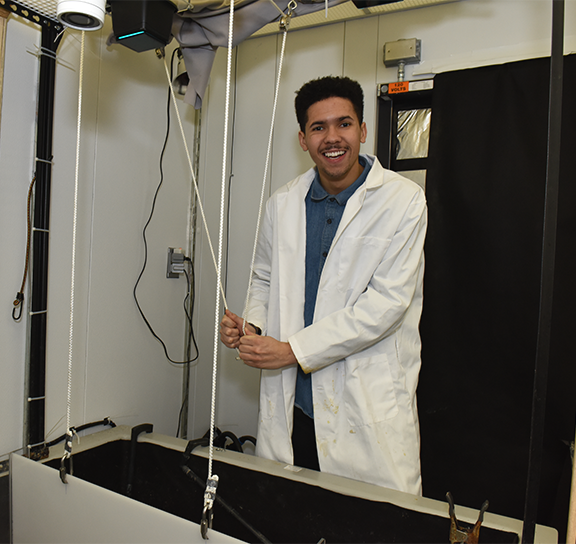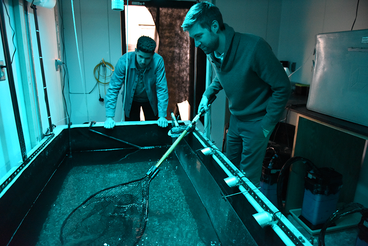UMD biology major Loranzie Rogers, or L.J., has a lot to be proud of right now. His research is going well, he recently won an award and $700 scholarship from the Minnesota Chapter of the American Fisheries Society (AFS), and next summer he will travel to Woods Hole, Mass., with Professor Allen Mensinger to conduct more research.
So, what is his area of expertise? Fish. More specifically, lean lake trout visual sensitivity.
Research Focus
So, why do we need to know more about fish eyesight? According to L.J.’s research supervisor Trevor Keyler, a UMD graduate student in integrated biosciences, “These results can give us better behavioral information to feed into models or simulations of lake ecosystems. The more we learn, the better we may be able to combat invasive species, too.”
A nice side effect is knowing what colors are best seen by fish in low-light situations which could come in handy when fishing, too. “I’ve always enjoyed fishing and did a lot of it while I was growing up, but I haven’t had a chance to try out what I’ve learned yet,” said L.J.
Fish Eye Exams
Testing a fish’s eyesight is no easy task. It involves a dark room and a lot of specialized equipment. Tiny electrodes are used to record the fish’s reaction to a flashing light that changes in color and levels of brightness. “There are so many things we have to take into account to ensure the data is obtained consistently and that it’s usable,” said Trevor. “The results are worth it, but it’s kind of a nightmare process.”
Of course, neither of them is complaining. They both love doing research. L.J. said, “We’ve had the research of past UMD students to build on and Dr. Mensinger expects us to do high quality work. It’s demanding, but it makes our work better.”
What’s Next?
Along similar lines, L.J. and Trevor are now starting a research project to measure the reaction distance between siscowet lake trout and their prey in different terrains. Their work is supported by a National Science Foundation grant and L.J. is a McNair Scholar as well as a participant in UMD’s Undergraduate Research Opportunities Program (UROP).
Like L.J., Trevor also received a Minnesota AFS award after recently finishing a master’s program. He is currently pursuing a doctorate. “There are so many opportunities to do research her,e and I hope students take advantage of that,” said Trevor.
L.J. agrees and said, “When I came on a campus tour at UMD, I remember seeing the people working in the labs and thinking about how I’d like to be doing that, and now I’m here. You just need to talk to professors and learn about what they’re doing and you could be a part of it, too.”
Visit the Swenson College of Science and Engineering (SCSE) website. Visit the SCSE Department of Biology website.

